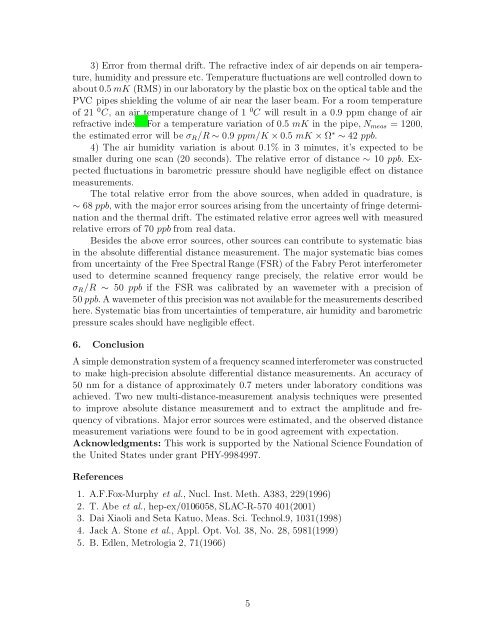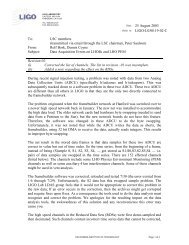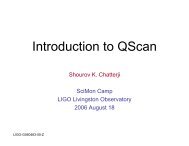High-precision Absolute Distance Measurement using Frequency ...
High-precision Absolute Distance Measurement using Frequency ...
High-precision Absolute Distance Measurement using Frequency ...
Create successful ePaper yourself
Turn your PDF publications into a flip-book with our unique Google optimized e-Paper software.
3) Error from thermal drift. The refractive index of air depends on air temperature,<br />
humidity and pressure etc. Temperature fluctuations are well controlled down to<br />
about 0.5 mK (RMS) in our laboratory by the plastic box on the optical table and the<br />
PVC pipes shielding the volume of air near the laser beam. For a room temperature<br />
of 21 0 C, an air temperature change of 1 0 C will result in a 0.9 ppm change of air<br />
refractive index. 5 For a temperature variation of 0.5 mK in the pipe, N meas = 1200,<br />
the estimated error will be σ R /R ∼ 0.9 ppm/K × 0.5 mK × Ω ∗ ∼ 42 ppb.<br />
4) The air humidity variation is about 0.1% in 3 minutes, it’s expected to be<br />
smaller during one scan (20 seconds). The relative error of distance ∼ 10 ppb. Expected<br />
fluctuations in barometric pressure should have negligible effect on distance<br />
measurements.<br />
The total relative error from the above sources, when added in quadrature, is<br />
∼ 68 ppb, with the major error sources arising from the uncertainty of fringe determination<br />
and the thermal drift. The estimated relative error agrees well with measured<br />
relative errors of 70 ppb from real data.<br />
Besides the above error sources, other sources can contribute to systematic bias<br />
in the absolute differential distance measurement. The major systematic bias comes<br />
from uncertainty of the Free Spectral Range (FSR) of the Fabry Perot interferometer<br />
used to determine scanned frequency range precisely, the relative error would be<br />
σ R /R ∼ 50 ppb if the FSR was calibrated by an wavemeter with a <strong>precision</strong> of<br />
50 ppb. A wavemeter ofthis <strong>precision</strong> was not available for the measurements described<br />
here. Systematic bias from uncertainties of temperature, air humidity and barometric<br />
pressure scales should have negligible effect.<br />
6. Conclusion<br />
A simple demonstration system of a frequency scanned interferometer was constructed<br />
to make high-<strong>precision</strong> absolute differential distance measurements. An accuracy of<br />
50 nm for a distance of approximately 0.7 meters under laboratory conditions was<br />
achieved. Two new multi-distance-measurement analysis techniques were presented<br />
to improve absolute distance measurement and to extract the amplitude and frequency<br />
of vibrations. Major error sources were estimated, and the observed distance<br />
measurement variations were found to be in good agreement with expectation.<br />
Acknowledgments: This work is supported by the National Science Foundation of<br />
the United States under grant PHY-9984997.<br />
References<br />
1. A.F.Fox-Murphy et al., Nucl. Inst. Meth. A383, 229(1996)<br />
2. T. Abe et al., hep-ex/0106058, SLAC-R-570 401(2001)<br />
3. Dai Xiaoli and Seta Katuo, Meas. Sci. Technol.9, 1031(1998)<br />
4. Jack A. Stone et al., Appl. Opt. Vol. 38, No. 28, 5981(1999)<br />
5. B. Edlen, Metrologia 2, 71(1966)<br />
5







